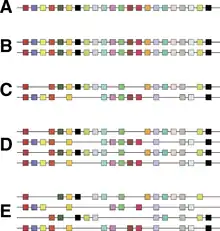2R-Hypothese
Die 2R-Hypothese (von englisch 2 rounds hypothesis ‚2-Runden-Hypothese‘, auch Ohno-Hypothese) ist eine Theorie zur Entstehung von Genduplikationen in den Genomen von Wirbeltieren.
Eigenschaften

Die 2R-Hypothese wurde 1970 durch Susumu Ohno aufgestellt,[2] die Bezeichnung entstand jedoch erst 1999.[3] Sie besagt, dass im Laufe der Evolution das Genom der frühen Wirbeltiervorläufer zwei Runden der Genomduplikation durchlaufen hat.[4] Ohno stellte seine Hypothese anhand von Genomgrößen und der Anzahl an Isozymen auf, später fügte er noch als weiteres Argument die fehlende Genkopplung bei einigen paralogen Genen hinzu, welche bei einer Genduplikation auf demselben DNA-Molekül auftritt.[5] Seine Beobachtung wurde 1993 durch die Charakterisierung paraloger Gene in Mäusen untermauert.[6] Die Duplikationen fanden vermutlich nach der Trennung der Wirbeltiere von den Manteltieren und Amphioxus statt,[1][7] vor etwa 450 bis 550 Millionen Jahren.
Die Gegenhypothese geht hingegen von einer Serie von Genduplikationen mit Crossing-over aus.[8][9]
Einzelnachweise
- Paramvir Dehal, Jeffrey L. Boore: Two Rounds of Whole Genome Duplication in the Ancestral Vertebrate. In: PLoS Biology. 3, 2005, S. e314, doi:10.1371/journal.pbio.0030314.
- Ohno S (1970). Evolution by Gene Duplication. London: Allen and Unwin, ISBN 0-04-575015-7.
- AL Hughes: Phylogenies of developmentally important proteins do not support the hypothesis of two rounds of genome duplication early in vertebrate history. In: Journal of molecular evolution. 48, Nr. 5, 1999, S. 565–76. doi:10.1007/PL00006499. PMID 10198122.
- K Hokamp, A McLysaght, KH Wolfe: The 2R hypothesis and the human genome sequence. In: Journal of structural and functional genomics. 3, Nr. 1–4, 2003, S. 95–110. doi:10.1023/A:1022661917301. PMID 12836689.
- W Makalowski: Are we polyploids? A brief history of one hypothesis. In: Genome Research. 11, Nr. 5, 2001, S. 667–70. doi:10.1101/gr.188801. PMID 11337465.
- LG Lundin: Evolution of the vertebrate genome as reflected in paralogous chromosomal regions in man and the house mouse. In: Genomics. 16, Nr. 1, April 1993, S. 1–19. doi:10.1006/geno.1993.1133. PMID 8486346.
- N. H. Putnam, T. Butts, et al.: The amphioxus genome and the evolution of the chordate karyotype. In: Nature. Band 453, Nummer 7198, Juni 2008, ISSN 1476-4687, S. 1064–1071, doi:10.1038/nature06967. PMID 18563158.
- AL Hughes: Phylogenies of developmentally important proteins do not support the hypothesis of two rounds of genome duplication early in vertebrate history. In: Journal of molecular evolution. 48, Nr. 5, Mai 1999, S. 565–76. doi:10.1007/PL00006499. PMID 10198122.
- A. L. Hughes, R. Friedman: 2R or not 2R: testing hypotheses of genome duplication in early vertebrates. In: Journal of structural and functional genomics. Band 3, Nummer 1–4, 2003, S. 85–93, ISSN 1345-711X. PMID 12836688.